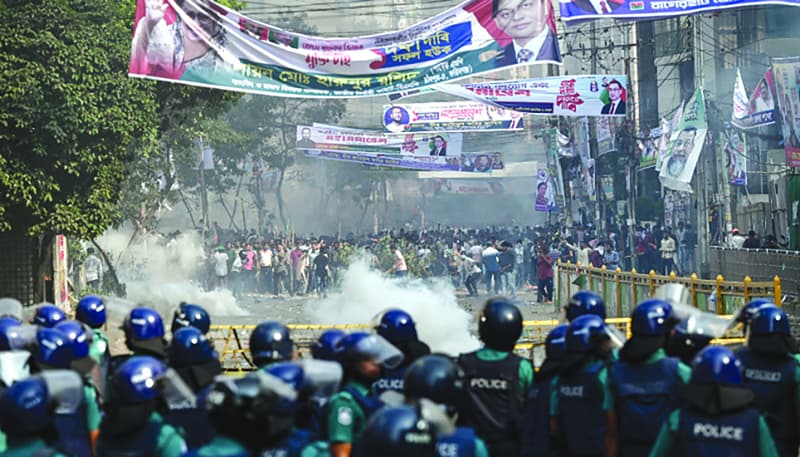Democracy Political Instability and Growth: What Shapes and What Shakes

Jamaluddin Ahmed FCA PhD
Is the former President of the Institute of Chartered Accountants of Bangladesh and the former General Secretary of the Bangladesh Economic Association. He is currently the Chairman of Emerging Credit Rating Limited
.
Two of the most active fields in economics in the past few years have been growth theory and political economy. Empirical and policy questions motivate both lines of research. The growth literature, with its new endogenous growth theories, analyzes economic factors such as education, openness, infrastructure, and government spending to determine which are more important or less important for growth. The political-economy literature argues that economics alone cannot fully explain the enormous variance across countries in growth and, more generally, in economic outcomes and policy choices. Political-economy models begin with the assertion that economic policy choices are not made by social planners, who live only in academic papers. Rather, economnic policy is the result of political struggle within an institutional structure. The empirically oriented researcher and the policy adviser have to be well aware of how politics influences policymaking.
This article reviews the recent literature that has grown at the intersection of these two very active areas of research. Specifically, we analyze what we have learned and what puzzles are left unsolved in the area of the sociopolitical determinants of growth. We focus on the relationships among four key variables: economic growth and capital accumulation, political instability, political freedom and democratic institutions, and income inequality (Alesina and Perotti (1 994). Both political scientists and economists have devoted decades to the study of these interactions (Huntington 1968 and Hibbs 1973). We do not attempt to offer a comprehensive review of this literature. For more comprehensive surveys see Adelman and Robinson (1988) on income distribution and growth, and Roubini (1990) on democracy and growth. We focus on the more recent research efforts in this area. Several recent papers have investigated various links among subsets of the variables listed above: income distribution and growth; political instability and growth; political rights, democracy, and growth; and savings, investment, and political instability. By taking a more systematic view of the interactions among the variables, this article attempts to clarify how all these contributions to the literature fit together.
This article discusses whether democratic institutions and, more generally, political rights foster or hinder economic growth. It discusses the relation between political instability and growth. The two key issues are how to define and measure political instability and how to account for the fact that neither of the two variables is exogenous to the other. Reviews the basic insights of several recent papers that have argued that income inequality is harmful for growth and reviews several theories linking income inequality and growth. Discusses the empirical evidence on the effects of inequality on growth, in particular, whether or not the evidence can distinguish between alternative theories.
Democracy and Growth
Do democracies grow faster than dictatorships? Do the noneconomic benefits of democratic institutions and civil liberties come at the price of low growth, or do civil liberties and democratic institutions foster economic development? To answer these questions, we need to make a distinction between two related definitions of democracy. The first identifies a democracy as a nation with regular, free, competitive (multiparty) elections. The second focuses on the amount of civil and economic liberties available to the population. The two definitions are not identical. In fact, some dictatorships that are certainly undemocratic according to the first criterion grant a fair amount of individual, and especially economic, rights to their citizens. The “four dragons” in Southeast Asia (Hong Kong, the Republic of Korea, Singapore, and Taiwan, China) are a good example. Consider the first definition of democracy. Why should free, multiparty competition negatively influence growth? Perhaps with political freedom, various pressure groups have a voice in the political arena. Their demands for redistributive policies may imply legislative deadlocks. Or their demands may be resolved by increasing the size of the government, in particular, the size of distributive programs rather than of productive expenditure. Furthermore, democratic institutions may be slow in responding to external shocks. Finally, in their efforts to be reelected, incumbent politicians may engage in suboptimal and shortsighted policies. Each of these arguments, however, has a rebuttal. Even dictators need to please various constituencies to avoid being overthrown (Ames 1987). Redistributive struggles between various socioeconomic groups can occur in various forms even without democratic institutions. In fact, where there is no constitutional way to change leaders, political change often requires violence and disruption of market activities. Thus, other things being equal, there seems to be no obvious correlation between democracy and growth. The recent empirical literature on this point is fairly unanimous in finding inconclusive results. Controlling for the economic determinants of growth, democracy has no effect on growth, either positive or negative. This result appears in several papers that have looked at cross-country regressions. Helliwell (1992), the most recent detailed study using this definition of democracy, reports inconclusive results. Alesina and others (1992) and Alesina and Rodrik (1994) report similar findings.
The explanation for these inconclusive results is that the (large) group of dictatorships is not homogeneous at all; several dictatorships (particularly in Southeast Asia) have done rather well in terms of growth; many others (particularly in Africa and Latin America) have done much less well. By contrast, the group of democracies is more homogeneous; the democracies have done much better than the worst dictatorships but not as well as some of the most successful dictatorships. The group of dictatorships may be disaggregated by differentiating the truly kleptocratic ones from the more benevolent. The truly kleptocratic dictatorships include those rulers who have aimed at maximizing their personal wealth and the welfare of their clan and close supporters and have to a large extent disregarded social welfare. The more benevolent dictatorships include the dictators who have followed policies favorable to the socioeconomic development of their countries. The problem with this exercise, of course, is that it becomes close to a tautology: growth is high in dictatorships that enhance growth and low in dictatorships that follow suboptimal policies. The pattern of correlations among democracy, income, and education raises the additional problem of difficulties in disentangling cause and effect (Helliwell 1992). The study reports sample means for variables measuring democracy, the rate of growth of gross domestic product (GDP), and education for selected groups of countries. It is quite clear from the study that democracy, GDP per capita, and education are highly correlated; rich countries are democratic and have high levels of education.
The second definition of democracy does not focus only on elections; rather, it focuses more generally on civil and economic rights. The most widely used index of civil liberties is the Gastil index, which ranks countries in seven groups. As with the first definition of democracy, arguments can be made that are consistent with either a positive or a negative correlation between civil liberties and growth. On the one hand, economic liberty fosters entrepreneurship, market activities, and growth. On the other hand, more civil liberties may translate into more conflicts over distribution. Results by Barro (1991) and Ozler and Rodrik (1992) suggest that, in fact, civil liberties are conducive to growth and capital accumulation. Measures of restrictions on capital mobility, trade restrictions, or other measures of economic regulations can be used as indicators of economic rights. It is straightforward to argue that less regulation and fewer obstacles to individual market activities should spur growth. For instance, the black market premium could be a proxy for economic freedom. The problem with these concepts of economic liberty, however, is that the results obtained by using them are virtually indistinguishable from statements such as “economic inefficiencies are bad for growth.” It is not completely clear whether these results on economic freedom imply something other than the fact that economic inefficiencies are not conducive to growth. In summary, there is no evidence that, on average, democracy with civil liberties is costly in terms of economic development. If anything, it may be the other way around, that democracy with civil liberties promotes economic development. This result is encouraging in view of the democratization process that has swept the world in the past decade, not only in Eastern Europe but also in large parts of the developing world. But establishing democratic institutions is not the “deus ex machina” that resolves all the problems of development. A sound and stable political-economic climate is essential.
Political Instability and Growth
Quantitative studies of the relation between political instability and growth have to tackle two major issues. The first is how to define political instability. The second is how to deal with joint endogeneity. Does political stability foster growth. Or does growth foster political stability. Or do political stability and growth reinforce each other. Researchers have defined and measured political instability in two ways. The first way uses an index of sociopolitical unrest that summarizes several indicators of more or less violent forms of political protest and social violence. The second way focuses on executive turnover, namely, on the frequency of government collapses. The first measure, which we label the sociopolitical instability approach, begins with a list of variables that identify events such as riots, political demonstrations against the government, and assassinations (Taylor and Jodice 1983 and Banks various issues). The researcher must then construct an aggregate index that projects in one dimension this multitude of variables. A statistical technique that leads to this type of reduction from a multidimensional set of variables to a single one is the method of principal components.
The classic reference for this approach is Hibbs (1973). In his large multiequation study, Hibbs finds that political instability has no effects on growth. Venieris and Gupta (1986) use the method of principal components to construct an index and show that it has a negative effect on the saving rate. However, the index of sociopolitical instability they use has some serious problems. One of the components of their index is a dummy variable for democratic regimes. The weight of this democracy variable is so large that the index is almost totally dominated by a classification of countries in the democracy or nondemocracy categories. Using measures similar to those of Venieris and Gupta, Ben-Habib and Spiegel (1992) argue that sociopolitical instability reduces investment. However, their empirical results are not very strong. The concept of sociopolitical instability has proven quite powerful in explaining other phenomena, especially in developing countries. For example, Ozler and Tabellini (1992) show that more instability leads to an increase in external debt in developing countries. Rather than constructing a specific index, Barro (1991) adds two political variables—the frequency of coups d’état and the number of political assassinations—in his cross-sectional growth regressions and finds that they negatively influence growth. Easterly and Rebelo (1993) find similar results.
The second approach to modeling political instability focuses on executive turnover. This executive instability approach begins by using probit regressions to estimate the propensity of a government to collapse. The independent variables in these regressions are political variables (protests, riots, executive reshuffling), economic variables (past growth, inflation), and institutional variables (whether the country is a democracy or not, the type of electoral system). A high estimate of the probability of a change of government is viewed as an indicator of executive instability. Before executive turnover was applied in the growth literature, Cukierman, Edwards, and Tabellini (1992) had used this measure of instability in regressions where the dependent variable is inflation. They conclude that political instability increases inflation. Edwards and Tabellini (1991) pursue this line of research further and show that executive instability leads to myopia in fiscal policy decisions in that unstable executives borrow more heavily than stable ones. Goodrich (1991) finds that in developing countries, foreign direct investments are negatively affected by this measure of executive instability. An important problem that many of these contributions do not formally address is the joint endogeneity of political instability and growth or inflation (exceptions are Hibbs 1973 and Gupta 1990). Economic variables such as growth and inflation can explain the propensity of government changes, which, in turn, are used as an explanatory variable for economic outcomes. Clearly, problems of simultaneity and reverse causality abound. Londregan and Poole (1990), using results by Heckman (1978), suggest a clever way of dealing with these problems. They estimate a two-equation model. One equation is a probit regression where the dependent variable captures the occurrence of coups d’état. The dependent variable in the second equation is growth in per capita income. Londregan and Poole find that poverty and, to some extent, low growth increase the likelihood of coups. Furthermore, coups d’état are persistent in that past coups increase the likelihood of future coups. Thus, if a country has a history of coups, it is likely to experience more coups in the future. And, somewhat surprisingly, they find that the propensity to have a coup does not reduce growth. Londregan and Poole (1992) confirm these results using a different sample and estimation techniques. Alesina and others (1992) adopt Londregan and Poole’s (1990) technique but use different specifications for both the growth equation and the executive change equation. First, they control for many more economic determinants of growth. Second, they focus not only on coups but on a broader definition of “government changes” which also includes constitutional changes of the executive. They consider the following as three separate variables: (a) every government change; (b) major changes in government, a subset of changes involving a substantial turnover in the political composition of the executive, that is, major government changes including all the coups plus a fraction of constitutional major cases of government changes (Alesina and others 1992); and (c) coups d’état. Although Alesina and others (1992) confirm Londregan and Poole’s results on the effects of poverty on coups, they find, contrary to Londregan and Poole, that a high propensity to executive instability reduces growth.
This result is quite robust and holds in several different specifications of the system. Recent results by Block-Blomberg (1992) confirm the findings of Alesina and others (1992) on this point. Alesina and others (1992), present statistics that highlight the basic results. The average frequency of government changes for the sample of all countries is 0.28; that is, governments change on average about every three years. The frequency of major government changes is 0.11, and the frequency of irregular government changes (military coups) is about 0.048. Military coups are most frequent in Latin America (0.078) and Africa (0.057) and practically nonexistent in industrial countries. Latin America has an average frequency of total government changes (0.29) similar to the world average, but it has the highest frequency of major government changes (0.16) and of military coups (0.078) in the world. In Africa, total government changes (and in particular nonmajor ones) are quite unlikely. African countries are typically authoritarian regimes with very few regular elections and changes in power. Executive changes mostly take the form of major changes (0.11), of which military coups are more than half (0.06). Finally, in Asia, government changes are close to the world average (0.30), but major government changes are much lower than in any other region.
Moreover, with the exclusion of the industrial countries, the frequency of coups is lowest in Asia. These data confirm the view of Asia as a region with authoritarian but stable political regimes. Note, however, that in years with coups, growth is substantially higher in Asia than in every other region of the world. Mauro (1993) and Knack and Keefer (1993) use another measure of political instability: subjective indexes collected by private organizations that are monitoring countries. These indexes are typically used by international investors to evaluate country risk. Both Mauro and Knack and Keefer report that instability has negative effects on investment and growth. They also find that subjective indexes of corruption and the quality of bureaucracy are negatively associated with growth. One problem is that measures of corruption are highly correlated with measures of instability. Whether or not these subjective measures provide any additional information beyond actual observations of sociopolitical variables remains to be seen. In summary, the following picture emerges: Poor countries are sociopolitically unstable. Since political instability reduces the incentives to save and invest and therefore reduces growth, poor countries may fall into a vicious circle. They are unstable because they do not manage to become rich, and they do not manage to become rich because they are politically unstable. A somewhat different view has been put forward by Huntington (1968), who concentrates on the causal link from growth to sociopolitical instability. He argues that it is not always true that all good things go together. When poor countries experience a period of takeoff and rapid growth, social unrest may actually increase. New demands are generated, the process of urbanization accelerates, and the entire society is in turmoil. This is not in general true for those rich countries that, for some reason, experience a period of high growth. Rich countries, unlike poor ones, already have the institutions in place to cope with social and economic transformations. Therefore, according to Huntington, the relation between instability and growth is nonlinear, and its sign depends on the level of development. It is positive for poor economies and negative for richer economies. The results of this section and the previous section lead to two interesting observations. First, growth is influenced not so much by the nature of the political regime (democracy or dictatorship) as by the stability of the political regime. Second, transitions from dictatorship to democracy, being associated with sociopolitical instability, should typically be periods of low growth. The social demands that were repressed under unconstitutional rule are likely to explode at the beginning of a new democratic regime. Until the new democratic regime is consolidated, it may face tremendous pressure to accommodate the conflicting demands of different groups. In addition, collapsing dictatorships are likely to bequeath to their successors serious economic problems for two reasons. First, poor economic performance is likely to be one of the causes of the collapse of the old regime. Second, collapsing dictators may follow very shortsighted policies because they have no future in office. Haggard, Shariff, and Webb (1990) and Haggard and Kaufman (1989) document that countries in transition perform worse in terms of many economic indicators than either established democracies or strong (established and not-collapsing) dictatorships.
These results have both positive and normative implications. From a positive point of view, they suggest an argument that might help explain different investment and growth performances in different parts of the world. Several countries in Southeast Asia have had very high growth rates in the post-World War II period. In the aftermath of the war, these countries had land reforms that reduced income and wealth inequality. Furthermore, and perhaps as a result of this reform, these countries have been relatively stable politically, compared with, for example, Latin American countries. The latter, in turn, have had a much more unequal income distribution, more sociopolitical instability, and lower growth rates. From a normative point of view, these results have implications for the effects of redistributive policies. Fiscal redistribution, by increasing the tax burden on investors, reduces the propensity to invest. However, the same policies may reduce social tensions and, as a result, create a sociopolitical climate more conducive to productive activities and capital accumulation. Thus, by this channel, fiscal redistribution might actually spur economic growth. The net effect of redistributive policies on growth has to weigh the costs of distortionary taxation against the benefits of reduced social tensions. In summary, the instability channel appears to be more successful, at least at this stage, than the fiscal channel. However, before drawing firm policy prescriptions based on these results, more empirical research is needed.
Discussion
The economic activities of the government within the national economy are continuously increasing over the years. Empirical studies in most countries clearly indicate that the government is rapidly growing (Aktan & Demir, 2016). There are economic, political, and social reasons behind the growth of the government. There is not only one but many reasons for the growth of the government. Population increase, urbanization, industrialization, wars, the need for economic development, the need for social welfare spending, etc., increase the activity of the government. Some of these reasons (for example, rapid population increase) make it necessary for the government to increase its activities. However, sometimes the government grows excessively and unnecessarily due to various reasons. These reasons actually stem from the political decision-making process. In the political process, the ruling party, in order to guarantee reelection, increases public expenditures. The bureaucracy may also become directly responsible for increasing the budget volume in line with the demand of the ruling government. In short, the government grows either out of necessity or in order to create benefits in the political process and to abuse political power. Before submitting any opinion or views on limiting and downsizing the government, the reasons behind the growth of the government and the consequences of such growth must be clearly understood.
The continuous growth of government is the actual cause of economic problems. As is known, public expenditures are generally financed by tax revenues. The part that cannot be financed by taxes is tried to be financed by non-tax revenues. The first economic problem due to the enlargement of the public sector is the budget deficit. For politicians, the increase in public expenditures means the guarantee of reelection. In contrast, financing public expenses by taxes is a burden on the voters. Therefore, the government tries to avoid this just before the elections for fear that they will lose votes. Therefore, the part that cannot be covered by the taxes results in budget deficits.
The government, which is elected, is obliged to increase the tax rates after the elections in order to settle the distorted economic balances and keep the promises they have made. Therefore, the tax burden is in the trend of increasing. The main negative results caused by the increase of the tax burden are: -Decrease of aggregate savings, -Decrease of aggregate investments, -Decrease of work efforts, -Enlargement of the underground economy. These results aroused in the economy finally cause low economic growth and development, a decrease in productivity, an increase in unemployment, and a decrease in tax revenues. In short, the heavy tax burden is the result of the growth of the government and causes distortive effects on the economy.
The growth of the government does not only cause economic problems but is also the source of political problems. Excessive government increases the gravity of political problems and political corruption in addition to economic problems. In the excessive government, political corruption such as bribery, corruption, embezzlement, pork-barreling, nepotism, etc., increases in extent. There is a social cost of excessive government as well. Traditionally, the government is seen as a “protective,” “corrective,” “improving,” and “curing” entity. There is no doubt that the government shall be responsible for providing security for the lives and property of its citizens. In this sense, the social benefit of the government is very extensive. However, seeing the government as an entity that corrects and improves everything creates a “public mentality” where everything is expected from the government. This understanding of an interventionist and paternalistic government is one of the main reasons underlying the excessive growth of the government.
The Government is absolutely necessary for a good social order. A social order without the government is unthinkable. However, the government is the source of, as well as the solution to, some problems. A “new” philosophy and a “new” public administration paradigm are needed to stop the government from being a problem, but a benefit to society. It is necessary to make realistic assessments and analyses to establish an ideal government. First of all, certain basic principles have to be accepted for a good or ideal government. A good government must be established on the following principles. The first basic principle is that there cannot be a “society without a government” as mentioned above. A society without a government is unacceptable since it brings chaos and anarchy. The power and authority of the government are not and cannot be limitless. The economic and political power and authority of the government must be limited within constitutional and legal rules. A government without limits that is not restricted by rules becomes the source of economic, social, and political problems.
The responsibilities and functions of the government, as well as its power and authority in the economic field, must be limited. Limiting the government does not mean downsizing the government in all areas. What is important is to determine what the government has to do in the economy and what functions and responsibilities it has to undertake. The question that needs to be addressed here is “How much do we need the government,” rather than “Is the government necessary”. The ideal government is the small but effective government. The functions and responsibilities of the government within the national economy must be limited as much as possible and the competitive market economy must be made functional.
The responsibilities and functions of the government can never be reduced to that of a minimal government. A minimal government is still a utopia. In other words, a government limited to defense, justice, and judicial authority seems not perfectly possible. The responsibilities and functions of the government must be determined by taking into consideration time, location, and socio-economic conditions. Therefore, the responsibilities and functions of the government vary from country to country. The government must have an institutional identity based on a social contract. This means; in each society, the power and authority of the government, the content, and limits of its responsibilities and functions must be determined based on social consensus and turned into a social contract (Constitution). A government that is not based on a social contract is not legitimate.
The Bangladesh Scenario
Bangladesh gained independence 52 years ago and established parliamentary democracy since its birth. The system of democracy, unfortunately, was disrupted by political instability and military takeovers in the post-independence era, which continued up to the 1990s with the fall of the military dictator in the same year. This created an opportunity to align the hostile political forces of the country—the Awami League and BNP—to come to a consensus on returning to Parliamentary democracy. But the desired political stability was not achieved; instead, it increased suffering and hindered the long-cherished growth prospects until 2008. Again, the lack of political stability, increased size of the cabinet, and public expenditure pushed Bangladesh to become the number one corrupt country during the period 2001-2008 and led the country to low economic growth. Once again, a military takeover was in place due to severe political instability up to 2006. The national election was held under the military government and was comparatively free, fair, and participatory. A voter list based on National ID was implemented, which could remove 1.25 crore fake voters from the list. The winning party, with a comparatively stable political situation, could help generate good indicators in terms of social, education, health, infrastructure, and financial development. The cost of Hartal and blockade used to cast a loss to the economy of BDT5000 crore in 2005 (UNDP 2005). With the increased value of the current GDP, the national loss on the ground of Hartal and Blockade per day amounts to BDT 15000 crore. This means if the nation undergoes 30 days of Hartal and Blockade, the loss multiplied by the GDP loss per day of BDT 15000 crore by 30 days, the figure comes to 4,50,000 crores, which is 8.33% of the annual GDP. This is a significant loss to the nation and a negative issue for future generations.
























